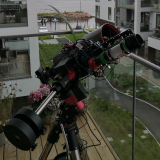INDI Library v2.0.7 is Released (01 Apr 2024)
Bi-monthly release with minor bug fixes and improvements
Ekos Planetary Imaging
- Jasem Mutlaq
-
 Topic Author
Topic Author
- Online
- Administrator
-

Replied by Jasem Mutlaq on topic Ekos Planetary Imaging
Please Log in or Create an account to join the conversation.
- Nguyễn Trọng Minh
-

- Offline
- Premium Member
-

- Posts: 136
- Thank you received: 9
Replied by Nguyễn Trọng Minh on topic Ekos Planetary Imaging
Please Log in or Create an account to join the conversation.
Replied by AstroMuni on topic Ekos Planetary Imaging
I particularly like the planet profiles that Firecapture allows you to setup. Thats a nice one to have too.
Pramod
My kit: SW 130PDS on a HEQ5 Pro mount, ZWO ASI533mc Pro, 30mm guidescope with ASI120mm mini, managed using Kstars/Ekos, RPi with Stellarmate OS, ASI224mc, bits and bobs for visual observations.
Please Log in or Create an account to join the conversation.
- Gustav Olav Lundby
-

- Offline
- Senior Member
-

- Posts: 48
- Thank you received: 0
Replied by Gustav Olav Lundby on topic Ekos Planetary Imaging
Please Log in or Create an account to join the conversation.
Replied by Axel on topic Ekos Planetary Imaging
I tried to get it working on stellarmate: groups.io/g/firecapture/message/2885
The FC screen opens, but a weird java popup with no content blocks me from going further. Very disappointing. Nevertheless, I think the Pi is not strong enough (even the Pi4 with lots of RAM) to handle planetary capturen (but I do not know, because, I can not test).
Cheers, Axel
Please Log in or Create an account to join the conversation.
Replied by Axel on topic Ekos Planetary Imaging
Deleted the Firecapture folder in the home directory and restartet FC, so the settings had been newly recreated.
Cheers Ael.
Please Log in or Create an account to join the conversation.
Replied by Marc on topic Ekos Planetary Imaging
in DS photography, all the tools used to make your images, run natively under Linux. (Kstars/Ekos/INDI, Siril, Gimp ...)
In Planetary imaging, the best tools used, run natively (and only) under Windows (AS!3, Registax, Astrosurface ... )
Wine isn't really an option as it cripples literally the performances of the programs. (slower, incomplete functions, impossibility to use the output of a program as an input to another... )
So a planetary tab in Ekos will have to work at its best under WINDOWS ...
- Marc
Please Log in or Create an account to join the conversation.
Replied by Marc on topic Ekos Planetary Imaging
In planetary imaging, like in sports photography, speed is the key.
A typical planetary camera like an ASI290mm at full frame (1936x1096) delivers 130fps.
That means roughly 2x130x8 = 2Gb/s
Do you think a Raspberry Pi will be able to grab & write a SD card at such a speed without losing frames ?
Of course, you can use ROIs for planets, but for the moon, you'll need full frame.
- Marc
Please Log in or Create an account to join the conversation.
Replied by Axel on topic Ekos Planetary Imaging
One thing to keep in mind :
So a planetary tab in Ekos will have to work at its best under WINDOWS ...
How would this work with INDI?
Please Log in or Create an account to join the conversation.
Replied by Axel on topic Ekos Planetary Imaging
Some thoughts ...
Do you think a Raspberry Pi will be able to grab & write a SD card at such a speed without losing frames ?
My Pi 4 has an M.2 NVME disc and does not run from SD card anymore (1 TB!)
Please Log in or Create an account to join the conversation.
- Peter Kennett
-

- Offline
- Supernova Explorer
-

- Posts: 1000
- Thank you received: 155
Replied by Peter Kennett on topic Ekos Planetary Imaging
github.com/Rolf-Hempel/PlanetarySystemStacker
github.com/Rolf-Hempel/PlanetarySystemSt...acker_User-Guide.pdf
Please Log in or Create an account to join the conversation.
- Adrian Knagg-Baugh
-

- Offline
- New Member
-

- Posts: 6
- Thank you received: 3
Replied by Adrian Knagg-Baugh on topic Ekos Planetary Imaging
As for processing, the usual Windows software (autostakkert!, registax, astrosurface) runs fast and well for me using recent Wine versions. I notice there are a lot of grumbling Wine logs, but the programs run well enough to achieve the required processing.
In terms of developing ekos for planetary capture, I think the first thing is to avoid doing anything to disimprove its deep space capture abilities. AstroDMX has support for INDI cameras since v2.0.2 although the author reports that there are issues with speed and for fastest capture the native drivers should be used, so perhaps the first thing might be to look at removing any bottlenecks to the data rate that might be caused by INDI. After that I guess ekos becomes just another capture application, so would need to look at implementing the same kinds of things as the other capture applications: high speed debayering and high speed preview rates, guiding based on the COG of the planet disc in view, auto ROI adjustment to help in coping with drift, setting of capture frame / time limits, tools like indication of RGB channel misalignment, etc. etc. One specific suggestion would be that the separation of all the camera settings into the INDI control panel is all very well for deep sky imaging where you don't change them often, but for planetary imaging it's much more convenient to have camera settings directly to hand so look at taking the best usability features from the existing front-runner planetary capture apps.
On the processing side, I write code for Siril; there is an ambition to improve our planetary processing capabilities in either the 1.3 development cycle or the one after that (it depends how we get on as there are also some other substantial feature additions as well as (if we're brave enough!) moving from gtk3 to gtk4... So hopefully there will be more native processing options in the not entirely distant future.
Please Log in or Create an account to join the conversation.
